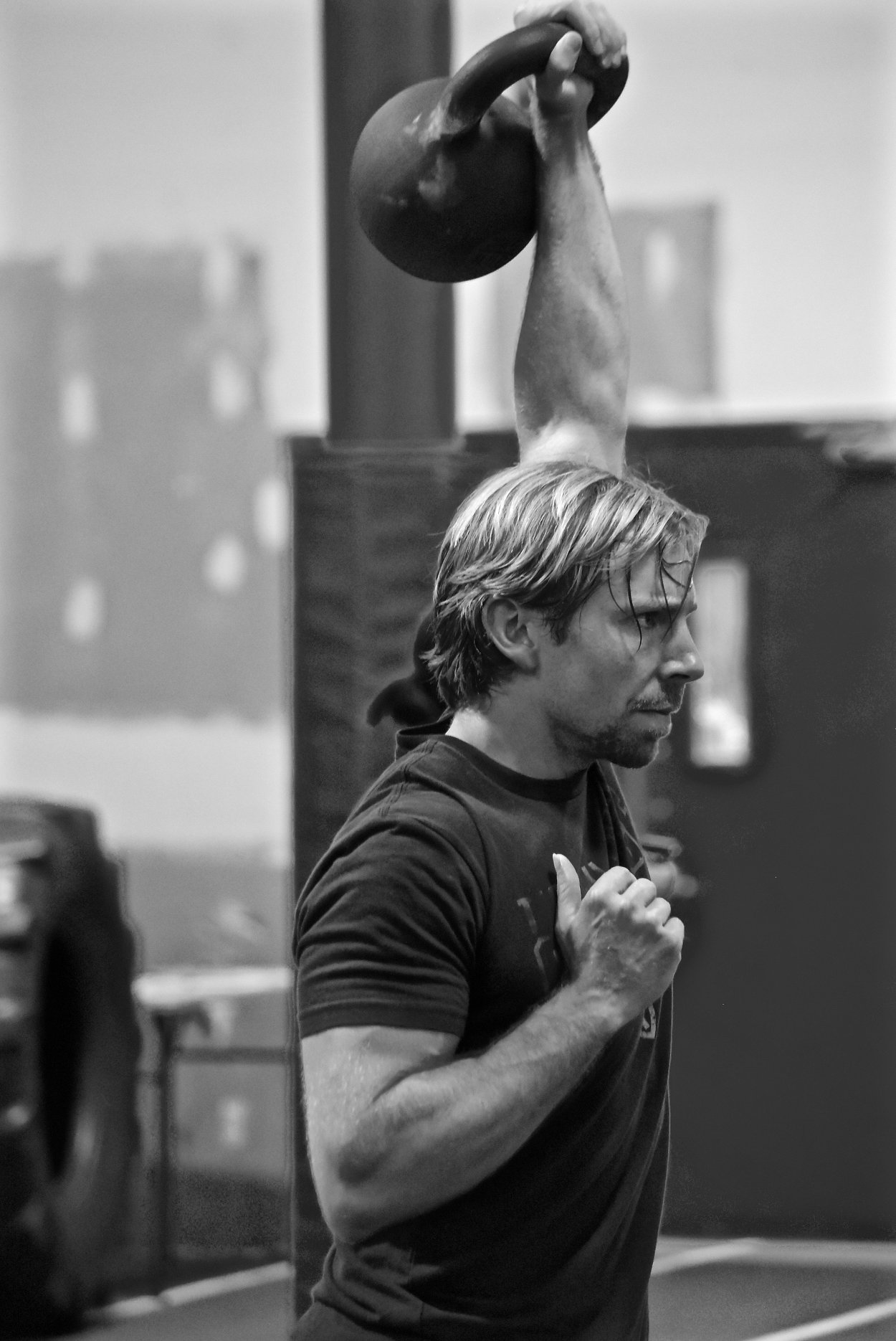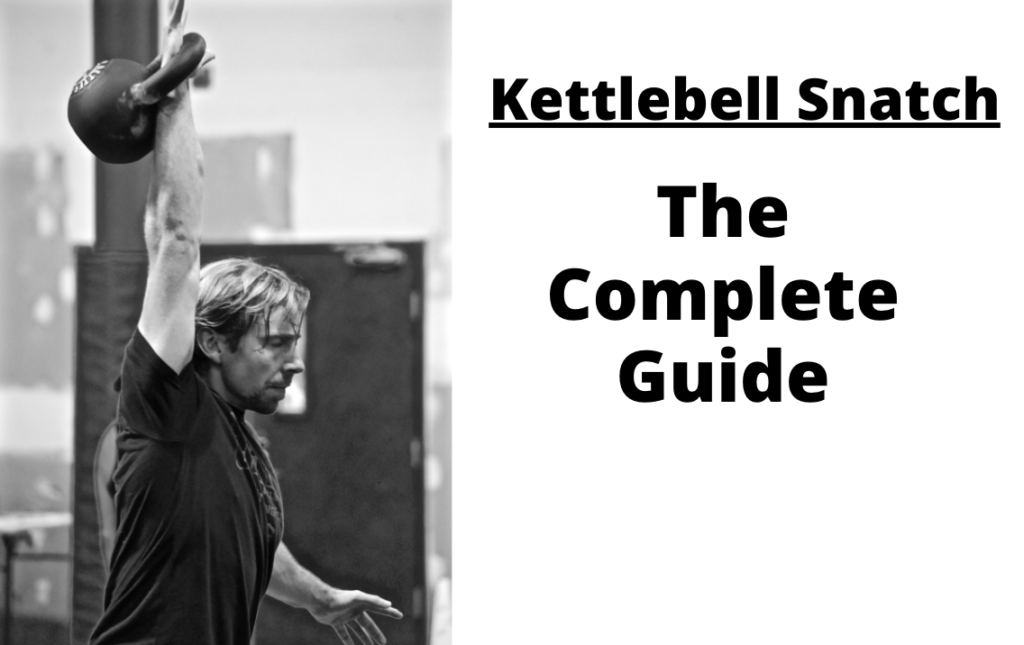
I get a ton of questions about kettlebell snatches from clients and readers, so here it is – your complete to guide on how to kettlebell snatch with proper form, common mistakes to avoid, and workouts to try.
Enjoy!
What is the kettlebell snatch?
The kettlebell snatch is an explosive, full-body exercise. It’s often considered among the most challenging of kettlebell lifts for two big reasons:
1) You’re moving a weight over the most distance physically possible (without letting go) – from the floor to overhead.
2) It’s fast. The only way to snatch a kettlebell is with speed and precision. You can’t do it slow and the only “resting” point is holding the kettlebell motionless at the top lockout.
From start to finish, the athlete hike passes a kettlebell into a hip hinge. Once the hips extend (as in the swing), the kettlebell is directed upwards and is “punched” into a locked-out overhead position (as in the military press). The kettlebell is then directed downwards until the hips “catch” the weight and the rep is repeated from the backswing or returned to the ground.
As you’ll soon find out, what happens in between the punch and the catch makes all the difference.
The kettlebell snatch is a true hybrid lift in that it builds strength, cardio, and power with every rep. Launching and stabilizing a heavy weight over your head requires a tremendous effort from every muscle in your body.
The start of the kettlebell snatch resembles a swing or deadlift. It is a hip hinge and thus engages the mighty posterior chain of hamstrings, glutes and spinal erectors.
This team of mighty muscles provides the “pop” and power that allows the kettlebell fly up without being pulled by the arms; like the initial rocket boost that launches the space shuttle out of Earth’s atmosphere.
Once the hips and legs lock out, the bell begins its journey skyward and that’s when the upper body takes command. (Of course, the quads and glutes remain tight to give you the rock-solid foundation you need to snatch safely and efficiently.)
In a flash, the core, pecs, lats, and upper back all coordinate to direct the kettlebell upward (not outwards like a swing).
The cherry on top of this sinister cupcake is the “punch” wherein the arm straightens out and absorbs the weight, supported by the triceps, shoulder girdle, and lats.
No muscle in your body comes out unscathed. Even your biceps and forearms get hit hard in this game of catch between hips and shoulders.
After a few snatches, you’ll feel as if you just ran up 5 flights of stairs with a full grocery haul – heart pounding, legs burning, and lungs suddenly wondering where all the air went.

In short – the snatch is tough and not for the beginner. Or faint of heart.
The kettlebell snatch delivers plenty of hard-earned benefits:
- a massive calorie burn in little time
- added muscle to the upper back and shoulders
- explosive hip power and hamstring strength without jumping
- high intensity cardio endurance without running
- the work capacity to sustain long, punishing efforts like moving a couch, hiking a mountain, or practicing martial arts
Yes – the juice is worth the squeeze, but it will take patience and persistence to get it right. The good news is that with a smart training plan, you’ll be able to avoid many of the pitfalls folks fall into when making a run at this exercise.
*Note – this article details my own training approach and interpretation of the hardstyle kettlebell snatch. Though they share a common name, the kettlebell sport snatch and barbell snatch (an Olympic lift) utilize different techniques and shouldn’t be confused with each other.
Before We Snatch —> 2 Kettlebell Pre-reqs
Before we dive into the full technique breakdown of the snatch, let’s make sure we have some prerequisites in order.
We must learn the snatch with safety and efficiency in mind. Doing so means using the strength and skills we develop through simple, foundational training.
A strong snatch depends on two major physical qualities:
- Hip power and endurance
- Shoulder mobility and stability
The hips and shoulders must coordinate in the blink of an eye to launch a kettlebell precariously close to, and past, your beautiful face – rep after rep.
Learning to snatch is no easy task, but you can expedite the process by ensuring you have a few performance standards under your belt.
1) Swings with a heavier kettlebell.
Hips drive the bell.
Again:
HIPS DRIVE THE BELL!
Your glutes are your engine, your source of power. And there’s no better way to train hip power than the kettlebell swing.
In fact, there’s a ton of overlap in the swing and snatch techniques – the critical “load and explode” phase is exactly the same.
So, if you expect to snatch a certain kettlebell, it should be easy to swing.
Here’s what I look for:
20 reps of 2-handed swings with a kettlebell 8kg+ heavier than your snatch weight.
10 reps of 1-handed swings with a kettlebell 4kg+ heavier than your snatch weight.
The swings should be strong, snappy, and have some decent height.
All good?
Let’s move up to the shoulders.
2) Turkish get-up with the snatch-sized bell
If you’re gonna snap and catch (is this where “snatch” comes from!?) a kettlebell in mid-air, you’d better be able to own that weight in various overhead static positions.
The TGU is an obvious choice for testing how your arms and shoulders hold up under stress.
The get-up sequence takes your shoulders from a horizontal press angle to a vertical press angle, hitting a bunch of in-between spots along the way.
A nice slow and controlled TGU should take 30-40 seconds per side, enough to demonstrate adequate endurance.
Show strength and stability (on both sides) with a certain kettlebell and your shoulders are probably ready to snatch it.
Kettlebell Snatch Technique Breakdown
The snatch should look as smooth and natural as a big ocean wave.
Like surfing, your goal is to delicately harness the powers of gravity and momentum to ride the wave to your destination.
The snatch has only two “resting” points – the ground and overhead – and there’s a lot that happens in between.
In fact, there are no fewer than 10 steps you need to know to snatch seamlessly.
Let’s take a look:
1) Set-up
Stand at arms-length behind a kettlebell, find your hip hinge “wedge,” grab the bell with one hand, and tip it back towards you. Look ahead, but don’t jam the neck.
Your pecs and lats should be tight – they’ll play a crucial role through the entire rep.
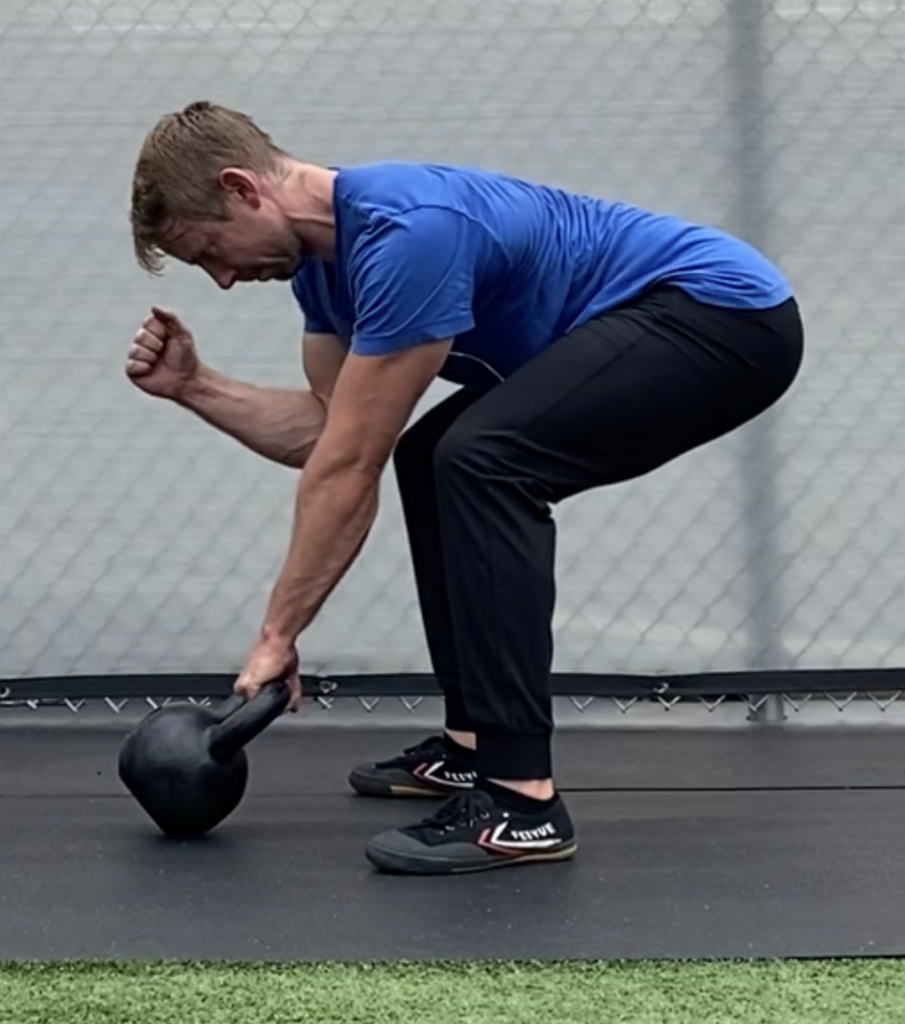
2) Backswing
While keeping the arm straight, pull the kettlebell up and back into the groin area by tensing the lats and triceps (think of a straight-arm lat pulldown).
The forearm makes contact with the inner thigh as you maintain the hip hinge position – knees bent, butt back, chest up. Keep your feet rooted and evenly balanced from toes to heels.
This is the “load” phase, like the pulling back of a bowstring.
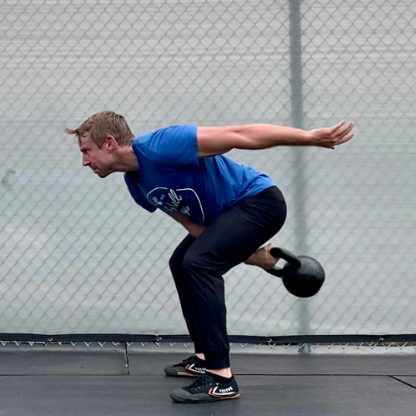
3) Hip snap
With the hamstrings, glutes, and back all stretched under tension, squeeze the glutes to drive the hips forward and stand up with a snap.
A couple points here:
> Keep solid contact between the forearm and inner thigh to prevent the kettlebell from falling down or forward (pecs and lats!).
> The hip snap ends with a tall, neutral posture. Watch the tendency to lean back and push the hips too far forward.
Only once the hips have extended does the kettlebell travel forward. This is the “explode” phase, like the launch of an arrow off the bowstring.
These first 3 steps remain constant when performing any kettlebell ballistic lift. Until the ascent, nobody should be able to tell if you’re about to swing, clean, or snatch.
4) Ascent
At this point, all the hard work has been done by the hips and the goal is simply to direct the trajectory of the floating kettlebell.
There are two points to consider:
> Keep the bell close to the body as this will ensure a smooth transition to the overhead lockout.
After the hip snap, bend the elbow and pull it slightly back to direct the kettlebell vertically.
> Keep the bell more towards the midline of the body to prevent getting your arms yanked off to the side.
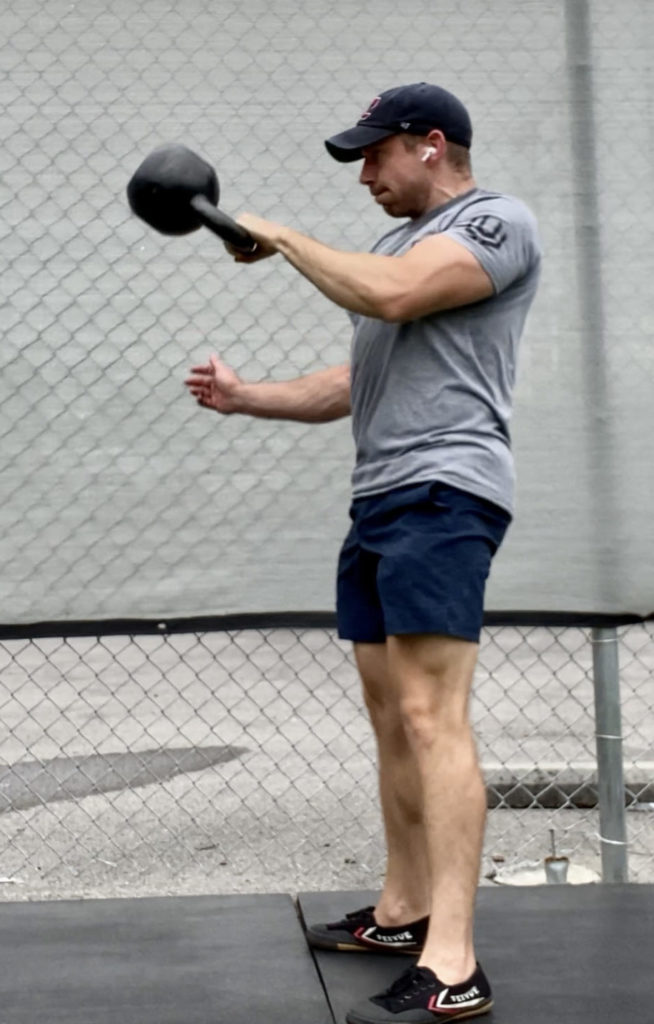
The pecs and lats act as guides to keep the arm and shoulder exactly where you want them. By keeping the pec engaged, you prevent the arm from moving too far out to the side.
Of course, some lateral travel will be necessary because we have to stack the kettlebell over one shoulder, but that should happen naturally in the next step.
5) Spear
This might be the most nuanced step and, admittedly, is the hardest to coach.
Assuming you launched with good hip power and kept the kettlebell close, it should still be free-floating and feel nearly weightless as it travels past head-height.
Now you must move your hand so the belly of the bell lands smoothly on back of the forearm.
Do this by spearing your hand through the handle, adopting a press grip – the handle settles deep into the palm lying diagonal from the thumb webbing to the pinky-side base of the palm – all in midair.
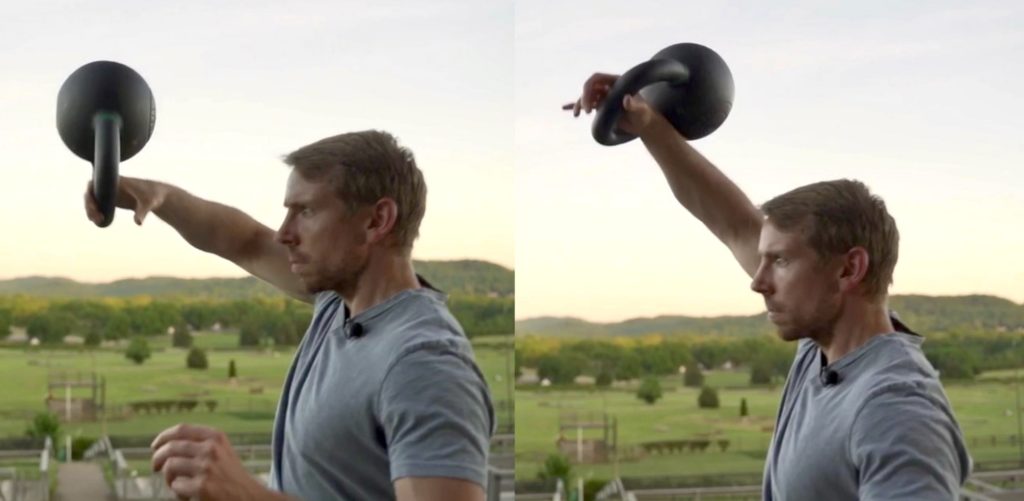
Making this move early (just over head-height) guarantees a smooth landing with the lockout.
6) Lockout
With only a few inches to go, the bell is already resting safely on the back of the arm and you’re riding the last little bit of upward momentum.
Now’s the time to stick your landing.
Here’s how:
PUNCH!
Absorb the weight of the kettlebell by stiffening the triceps, shoulder girdle, and lats. Punch the sky but keep the shoulder locked down tight. With adequate mobility, you’ll end up with your biceps right by your ear.
Pause and make sure everything feels stacked and engaged.
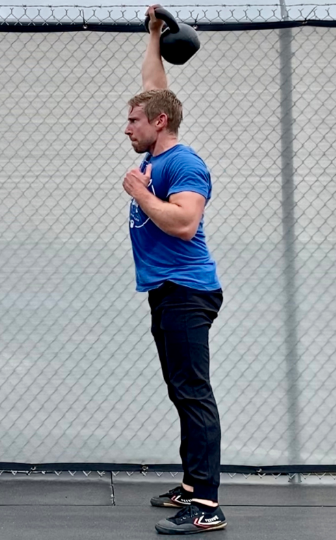
One caveat:
Yes, the cue is “punch,” but that doesn’t mean you need to make a tight fist. Assuming you got step 5 right, the bell is in a secured position independent of the fingers.
In fact, you can even lockout with a wide open hand to reinforce the deep palm position and to focus on the alignment and engagement of the rest of the body.
7) Tip
Here’s another tricky step to coach because it happens so fast and, really, there’s not much to it.
We’re simply doing the reverse of step 5 – allowing the kettlebell to fall as we switch the grip orientation from the base of the palm back to the fingers.
Start the descent by tipping the wrist forwards and unlocking the elbow.
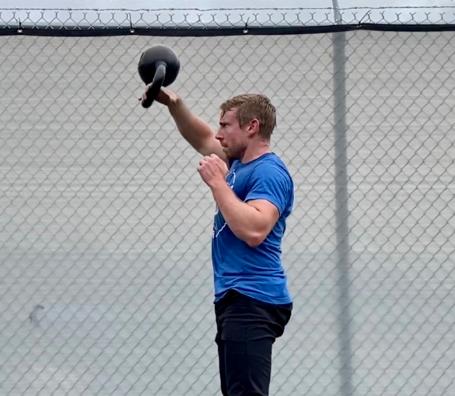
Release any urge to over-grip the kettlebell. We want it in a free fall.
8) Descent
Again, we are matching and reversing step 4 and the cues are mostly the same:
Keep the bell close and guide it back towards the midline of the body.
Yes, the kettlebell is in free fall, but we can still control the arc by engaging through the lat and keeping a good bend in the elbow.
Now weightless in the air, move your hand to get your fingers loosely around the handle – how you would grip for a swing. The sooner you get there, the better.
By the time the kettlebell is around bellybutton level, 4 things should begin to happen:
- The lat and tricep squeeze into each other
- The elbow straightens
- The grip tightens around the handle
- The breath comes in through the nose
These all set you up for a safe transition into the backswing.
9) Backswing
A near copy of step 2, we catch the kettlebell with the hips like a goose egg in a baseball glove – softly!
Careful not to begin the backswing too early.
Many lifters, panicked by a hunk of iron hurdling towards their privates, move the hips before the arms re-connect to the torso (triceps meet lats). This puts stress on the low back and messes with the rhythm of the snatch.
As the knees bend and hips fold, actively “pull” the kettlebell with your lats deep into the hinge position. This will maximize upper back engagement – a key point for safety and power.
With a belly full of air, feet firmly planted flat, and hamstrings taut like a bow, you now have two options:
- Perform another rep (repeat the hip snap) or
- Park the kettlebell and end the set
10) Park the kettlebell
With the kettlebell loaded up high in the backswing, simply keep the hips right where they are and hold the inhalation to keep the abs braced.
Allow the kettlebell to swing forward and gently place it where you found it.
We’ve ended right back where we started. DONE!
Let’s wrap up this section with two more quick points on snatch technique.
How should one breathe for the kettlebell snatch?
For maximal power – in through the nose during the backswing and out through the mouth with the hip snap just like the swing).
That said, plenty of kettlebellers overuse the “power exhalation” through the mouth and end up gassing out or losing focus on the actual mechanics of the lift.
Plus, how often do we really need that extra oomph?
For most training reps, I suggest a nasal-only breathing style – inhale with the backswing, exhale with the hip snap, and an extra mini breath cycle at the lockout or descent if needed.
Where should one grip the kettlebell handle during the snatch?
Every cast iron kettlebell will have different dimensions based on weight and coating materials will vary between brands.
Combine those factors with your own hand size, strength, and callus development and we’ve got a big question mark here.
The principal concern for hand placement is how easily you can transition between a swing-grip (handle gripped in the fingers) and a press-grip (handle anchored at the base of the palm) while sparing the calluses.
Experiment with 3 grip placement on the kettlebell handle – thumb side, middle, and pinky side. Each angle will give the snatch a different feel and one might help you achieve the smoothest lockout.
You can even change your grip orientation mid-set to distribute the wear pattern and prevent blisters.
Assistance Exercises for the Kettlebell Snatch
I’ve taught the snatch to personal training clients, workshop groups, and online students around the world…
I’ve compiled all my best teaching cues in this article and numerous videos…
But no matter how much you “know” about the snatch, you won’t nail it before getting in lots of practice. And how you go about practicing makes all the difference.
The snatch is an unforgiving lift.
Bruised forearms, torn hands, and tweaked shoulders are all but guaranteed if you jump right in to the full snatch, even if your swings and get-ups are dialed in.
The good news is there are a handful of progressions that allow you to practice the various snatch techniques safely and in isolation before committing to full reps.
1) High swing
You know the hips power the momentum of the kettlebell.
You also know the arms subtly guide the arc and trajectory of the kettlebell.
The high swing allows you synchronize the hips and arms without fussing over grip changes.
The drill is simple – just swing, keep the bell close to the body (“tame” the arc), allow it to float momentarily overhead, and guide it down in the same arc.
This is basically 80% of the snatch movement, we’re just eliminating the handle pass and lockout.
Focus on the mid-line alignment and how much height you can summon out of a kettlebell while keeping it under control.
2) Snatch up
Click for slow-mo video:
Building off the high swing, now we just add the spear and lockout – steps 1-6.
From the top, slowly bring the kettlebell back to the rack position (as in a military press).
Park the bell or backswing and repeat.
3) Clean Drop
Successfully passing the kettlebell handle from the base of the palm to the fingers without catching the callus line is one of the trickiest maneuvers in kettlebell lifting.
We can train this skill in a low-risk environment by practicing the drop from the rack or clean position.
Simply clean a kettlebell and take a mental note of how the handle feels in the palm. In theory, the bell rests on the arm the same – whether overhead or racked at the shoulder.
Let the bell fall away as you open your hand, re-grip the handle with the fingers in midair, and pull into the backswing – a repeat of steps 7-9 while only traveling half the distance.
4) Snatch Drop
Click for slow-mo video:
By now, you’ve ingrained the feeling of a smooth grip pass between palm and fingers.
With the snatch drop or snatch eccentric, you’ll drop the bell from overhead, tame the arc, and catch in the backswing (steps 7-9).
Clean and (push) press the kettlebell to return to the overhead position. You must get comfortable with the snatch up and the snatch drop independently before performing them together.
5) The Clock Snatch
The final assistance drill focuses on the spearing technique.
Remember from step 5, timing is everything for getting the bell to the forearm smoothly.
Many lifters spear through too late, causing the kettlebell to crash land and bruise the forearm, destroying any sense of control or coordination.
This exercise forces you in the opposite direction – spearing through early.
Here’s how:
Your overhead lockout (perfectly vertical) is 12 o’clock.
Your arm straight out (parallel to the ground) is 9 o’clock.
Simply, you will “snatch” to 9, 10, and 11 o’clock before settling on high noon. Obviously, you won’t hold any lockout in the first few positions, but you’ll develop a feel for getting around the handle on-command.
While I recommend training these assistance moves in the sequence laid out above, your strengths and areas for improvement might dictate otherwise.
Experiment!
And always stop to regroup if you hit a couple sloppy reps in a row.
Mentally check in and have a specific intention and goal for every set.
Kettlebell Snatch Workouts
Beginner:
As a beginner, your priority is to get comfortable with the snatch techniques and build the strength needed to handle more weight and training volume.
Try this chain (1 rep of each):
Swing, high swing, snatch, negative to the rack.
2-3 rounds and repeat other side.
Intermediate:
As an intermediate, you can incorporate snatches into strength complexes or train them for endurance and work capacity.
Here’s an example of each:
Clean + Press x 3
Snatch x 5
Squat x 8
3-5 Rounds each side
Every minute on the minute x 10 minutes:
Even minutes – Heavy 2-H swings x 10
Odd minutes – Snatches x 10/10
Advanced:
As an advanced snatcher, you might be inclined to tackle something like the Secret Service Snatch Test (200 reps in 10 minutes) or play around with techniques like the bottoms-up snatch, tactical switch, or double snatch.
If you’ve got a football field and a couple kettlebells handy, try this:
Snatch a heavy weight, hold overhead, and walk 5 yards.
Drop and snatch back up, walk 5 yards.
Repeat to the 50 yard line and switch arms.
Once you reach the end zone, snatch a light kettlebell for 50 total reps.
If you’re insane, do it all again back down the field.
Go forth…
To the unknowing eye, the snatch looks simple… and, with time and practice, it is. The lifter who puts in the work will make the very difficult appear effortless.
And that’s the goal – make all these techniques flow together and, eventually, forget them.
Whew! That was a lot.
Want this article broken down into an easy-to-reference cheat sheet?
Click here to snag your copy and get my best, most wicked kettlebell snatch workouts to burn fat fast and build the endurance and power of a racehorse.
